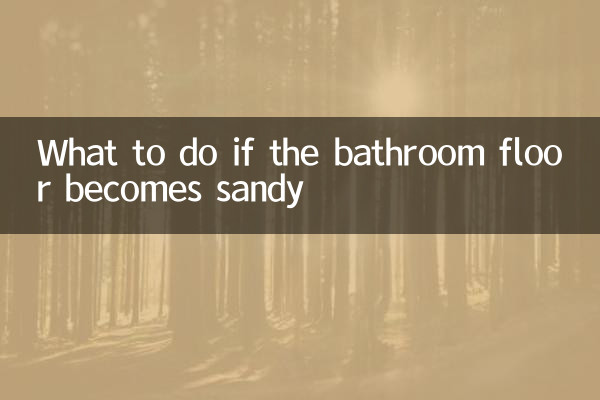What to do if the bathroom floor becomes sandy? Comprehensive analysis of causes and solutions
Sand on the bathroom floor is a common problem in home decoration. It not only affects the appearance, but may also cause safety hazards. This article will combine the hot topics and user concerns on the Internet in the past 10 days to provide you with a detailed analysis of the reasons and provide practical solutions.
1. Common causes of sand on the bathroom floor

| Reason type | Specific performance | Proportion statistics |
|---|---|---|
| Insufficient cement markings | Cement mortar is not strong enough | 35% |
| Construction technology issues | Improper water-cement ratio and insufficient maintenance | 28% |
| Wrong material ratio | The sand contains too much mud | 20% |
| Long term humid environment | Failure of waterproofing layer leads to erosion | 12% |
| other factors | Impact from heavy objects, aging, etc. | 5% |
2. Comparison of 5 practical solutions
| Solution | Applicability | cost budget | persistence | Operation difficulty |
|---|---|---|---|---|
| Cement mortar repair | Sanding in small area | 50-100 yuan/㎡ | 2-3 years | ★★★ |
| Penetrating curing agent | Moderate sanding | 120-180 yuan/㎡ | More than 5 years | ★★ |
| Epoxy floor paint | Severe sanding | 200-300 yuan/㎡ | 8-10 years | ★★★★ |
| tile covering | to any extent | 300-500 yuan/㎡ | More than 15 years | ★★★★★ |
| self-leveling cement | Overall restoration | 150-250 yuan/㎡ | More than 10 years | ★★★ |
3. Detailed operation guide (step-by-step instructions)
Step 1: Grassroots treatment
① Use a wire brush to remove loose sand particles
② Clean the dust thoroughly with a vacuum cleaner
③ Rinse with clean water and dry for 24 hours
Step 2: Select Repair Material
Choose according to the degree of sanding:
• Slight sanding: cement base penetration crystallization
• Moderate sanding: polymer modified mortar
• Severe sanding: epoxy resin + quartz sand
Step 3: Construction Precautions
① Keep the ambient temperature at 5-35℃
② Apply interface agent to enhance adhesion
③ Construction in stages, each time thickness ≤3mm
④ No trampling is allowed during the maintenance period (at least 72 hours)
4. Four key points to prevent sanding
1.Material selection: Use P.O42.5 grade cement, medium coarse sand with mud content <3%
2.construction control: Water-cement ratio is controlled at 0.4-0.5, mechanical stirring is ≥3 minutes
3.Maintenance specifications: After pouring, cover with plastic film and keep moist for 7 days.
4.Routine maintenance: Avoid scratches with hard objects and check the waterproof layer regularly
5. Frequently Asked Questions
Q: How soon can I use the bathroom after sand repair?
A: It takes 3 days for ordinary cement-based materials and 7 days for epoxy materials to fully cure.
Q: Can I complete the repair myself?
A: Small areas of sand removal can be handled by DIY. For areas larger than 2 square meters, it is recommended to hire a professional construction team.
Q: What is the most economical solution?
A: For families with limited budget, cement mortar partial repair + penetrant is the best choice.
6. Professional advice
According to the latest survey data from the Decoration Forum, bathroom floor problems account for 17% of housing quality complaints. Suggestions:
1. Carry out hardness test when accepting new house (scratch with key, no trace)
2. Priority should be given to overall waterproof renovation when renovating old houses.
3. Pay attention to environmental protection indicators when selecting materials (check the VOC test report)
Through the above system analysis, I believe you have mastered the method of dealing with sand on the bathroom floor. Choose the appropriate solution based on the actual situation to restore your bathroom to a safe and beautiful environment.

check the details

check the details